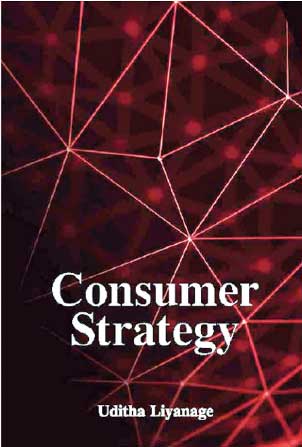Sunday Apr 20, 2025
Sunday Apr 20, 2025
Monday, 1 February 2016 00:00 - - {{hitsCtrl.values.hits}}
 It has been almost six months since the sad demise of Prof. Uditha Liyanage. A collection of his articles was posthumously published by the Postgraduate Institute of Management in a book entitled ‘Consumer Strategy’. Today’s article is an attempt to share thoughts as a reader, or in fact as a consumer, about ‘Consumer Strategy’. I am not competent enough to review this masterpiece so in essence this is a non-marketer’s perspective.
It has been almost six months since the sad demise of Prof. Uditha Liyanage. A collection of his articles was posthumously published by the Postgraduate Institute of Management in a book entitled ‘Consumer Strategy’. Today’s article is an attempt to share thoughts as a reader, or in fact as a consumer, about ‘Consumer Strategy’. I am not competent enough to review this masterpiece so in essence this is a non-marketer’s perspective.
Overview
‘Consumer Strategy’ is a compilation of comprehensive articles written by perhaps the most conceptually rich person I have ever met. His ingenious ideas have immensely inspired us by inviting us to be intellectually enriched and interactively engaged. I am glad that I had the privilege of being mentored by him but at the same time I am sad that it could not continue.
The 20 articles contained in this volume are all selected by Prof. Uditha Liyanage himself, sometime ago. They cover a wide range of topics in the broad domain of management, with specific emphasis on marketing and strategy. The depth of conceptual appeal and the breadth of concrete application appear as the hallmark of the veteran author. A variety of valued marketing models developed by Prof. Liyanage are included in this volume, inviting readers to think afresh instead of blindly following western marketing models. The same is true of strategy as well.
Ironies of life
The book’s acknowledgement, written by Ms. Chathuri Liyanage, Prof. Liyanage’s daughter, states as follows: “Life is a journey. A journey that takes you to places and situations you never intended or thought you will face. Such is the malleable and unpredictable nature of this journey we undertake called life. My father too like everyone else embarked on this journey but due to unforeseen circumstances had to face a steep hill of his own. Although my father climbed this hill with laudable courage and determination, fate overtook him.
“Throughout the years I have watched my father write these articles with great enthusiasm. I would like to thank everyone who contributed even in the smallest measure to make this publication a reality.”
We were keen on launching Consumer Strategy together with a felicitation ceremony for this fascinating human being. Destiny decided otherwise. Nevertheless, Prof. Uditha Liyanage will continue to be alive in our minds through his myriad insights.
We at PIM commit ourselves to carry his legacy forward. The publication of Consumer Strategy is one significant step in that solid endeavour.
Key contents
As has always been the case, Prof. Liyanage invites us not just to read the book but to recognise the key themes, reflect on the main ideas, relate to the concepts covered to the current challenges.
It should reinforce the way how one professionally applies the key lessons, in playing a managerial and leadership role in one’s workplace.
In essence, knowing should lead to doing and that in turn will deliver results.
‘Consumer Strategy’ essentially revolves around two key themes - consumer and strategy. Among the articles related to the consumer aspect in the broad spectrum of marketing, Marketing Strategy and Society: From CSR to SRB is an interesting one.  Prof. Liyanage clearly differentiates philanthropy from strategic Corporate Social Responsibility (CSR).
Prof. Liyanage clearly differentiates philanthropy from strategic Corporate Social Responsibility (CSR).
We need this clarity, as I saw in the judging process of the last National Business Excellence Awards, where there is often confusion between the above two terms.
Among the other insightful papers, ‘Brand Marketing: From 1P to 6Ps’, ‘Five Hats of the Consumer’, ‘Goods - Services Dichotomy: The Place of the Tangibility Construct’, ‘Towards a Positioning Strategy for Tourism in Post-war Sri Lanka’ and ‘Consumer Behaviour and the Anatomy of a Brand’ appear prominently. Also, ‘Profiling the Sri Lankan Consumer’, ‘A Customer Value Typology: Beyond the Functional - Emotional Dichotomy’ also offer many insights.
Prof. Liyanage’s conceptualisation of ‘Sri Lanka’s New Mod-tradi Consumer’ is indeed an interesting one.
“The seemingly opposing socio-cultural forces of traditionalization and modernization have to be clearly recognized in our attempt to profile the emerging Sri Lankan-consumer. The force of traditionalization gathered momentum in the post-1956 period, while the impetus of modernization was felt particularly in the post-1977 period. Escaping the attention of many, the two forces of traditionalization and modernization have been converging, over the recent past, giving rise to the post-modern consumer.” (Liyanage, 2015)
“The harmonization of the traditionalist and modernist forces gives rise to postmodernist tendencies in the Sri Lankan marketplace,” observed Prof. Liyanage. “A mismatch of the two produces either an overly traditional, and therefore, an old-fashioned and obsolete proposition or a hyped rendering of an overt western and modernist proposition.”
He further states: “The former lacks appeal in that it may be considered to be desirable, at best, but not necessarily, desired. The latter will be treated, other than by an insignificant minority, as an aberration; as one which lacks relevance and social acceptance.
“The challenge of today’s marketer is to sense the emerging postmodernist propensities of the emerging consumer and develop propositions and products that avoid the two extremes of being either overly traditionalist or modernist. Such an endeavour must be based on the recognition of the points of confluence and fusion that appeal to a new breed of postmodern consumers.
This in turn would be possible only through the deep-going understanding of the psyche and the behaviours of the new and emerging Sri Lankan postmodern consumer,” he concludes.
Strategy focus
Prof. Liyanage gave a new twist to the often hacked term, strategy. His bold arguments are present in the article, ‘Planning is not Strategy: Big 5 Strategy Questions’.
“Strategy is often confused with planning. The many definitions and delineations of strategy, which highlight one or more aspects of strategy, while ignoring the others, have led to a state of confusion as to what strategy really is. This is evident in the content-analysis of the vision, mission and value statements of a number of companies. Not only were the analysed company – specific statements vague and general, they were also unrelated to one another. Specifically, the espoused values were generic and terminal in nature and unrelated to the tasks and goals at hand.” (Liyanage, 2015)
In order to avoid confusion in the minds of practitioners, and as reflected in the literature itself, Prof. Liyanage proposes a Strategy Quadrant, consisting of Stand, Standing, Shared Values and Supportive Resources and Capabilities, and Steps.
“Seeing strategy as action is also flawed. ‘Our strategy is to merge …’, and ‘….to double our research and development expenditure’ are common place expressions which tend to pass off as strategy,” observes Prof. Liyanage. “Putting the planning cart before the strategy horse is a blunder that bedevils many an organisation in its attempt to hone strategic action,” he opines.
In a more applied manner, Prof. Liyanage has elaborated on how strategy execution took place in the battle front. This article is based on the content analysis of two comprehensive post-war presentations made by military experts. The way he compares the adaptation of suitable military strategies to marketing is indeed insightful.
“Don’t be an “arm chair” leader but a “behind the wheel” leader! When the leader has superior knowledge of a particular area of activity, not making full use of it in his direct engagement with operations, is a waste of a vital resource. The often- espoused leader-role hinders such a direct approach.” (Liyanage, 2015)
Among the other interesting articles related to strategy, ‘The Myth of Pay-for-Performance’ and ‘In Search of Resilience: From Pilot to Architect’ also offer salient points to ponder.
“Letting a turbulent environment get the better of you is fraught with the prospect of extinction. Responding to turbulence with resilience is the way forward. The Darwinian approach of adaptation as reflected in the rebound cycle is natural. Its intent is to get through the crisis and emerge unscathed as far as possible. A more Singarian approach, characterized by an internal locus of control as reflected in a renewal cycle, is to continually renew oneself in order to stay ahead of unfolding patterns and the trajectory of turbulence.” (Liyanage, 2015).
Way forward
The book ‘Consumer Strategy’ highlights his purpose as a thinker. His thoughts will spark our minds for a long time. We at PIM are indeed proud of our profound management legend and will continue to preserve his intellectual capital for generations to come.
I earnestly hope that ‘Consumer Strategy’ will meaningfully stimulate readers by showcasing a true management sage of our age through his distinct deliberations.
(Prof. Ajantha S. Dharmasiri can be reached at [email protected])